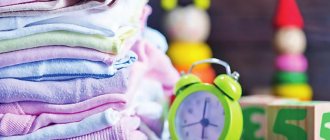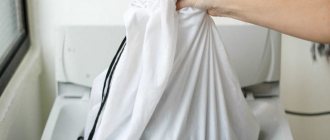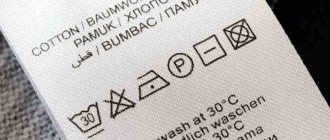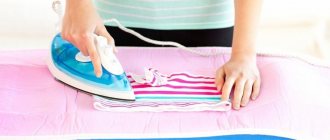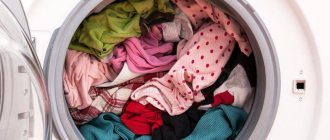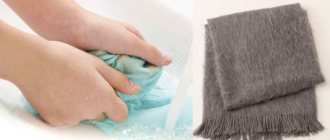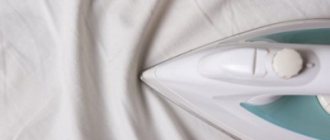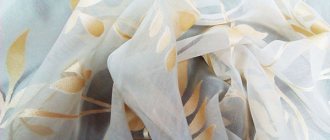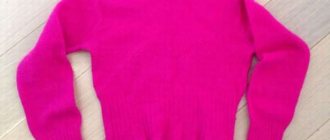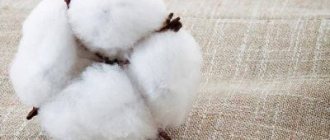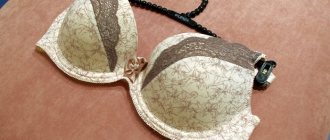Children's skin is very sensitive to mechanical stress, fabric quality, and detergents. It is especially necessary to handle clothes for newborns with particular care, since the wrong choice of materials can lead not only to wounds and diaper rash on the baby’s body, but also to much more serious allergic reactions.
Particular care should be taken when washing rompers, vests and diapers for newly born babies. Every young mother should know how to wash baby clothes for newborns even before the baby is born. The dowry must be ready (washed, ironed), first of all, for the maternity hospital. A baby comes into contact with clothing from the first hours of its life, so the parents’ task is to choose the softest, safest clothes possible, and also wash them correctly.
Tips for washing clothes for a newborn baby
Everyone knows that washing things regularly is important for your health. This is especially important if there is a child in the house. It should be carefully looked after, because babies have delicate skin and weak immunity. You should start by destroying harmful microorganisms. Of course, today it is much easier to wash thanks to the advent of modern technology, but you still need to take into account several features.
Basic requirements for children's washing powders
Of course, if you are concerned about the health of your baby, you need to use a safe washing powder that will not harm your baby’s delicate and defenseless skin. So, what powder should you use to wash a newborn’s clothes, because their variety and the name “children’s” do not always mean that they are such.
Now on store shelves you can find a huge variety of both the powders themselves and their manufacturers. At the same time, the choice undoubtedly remains with the parents and depends on their financial capabilities.
But know that for washing, Japanese powders or imported European ones are not always better than domestic ones, because the main thing is the composition, which you need to pay attention to first of all.
So, the main requirements that you should pay attention to when choosing are as follows:
- The absence of harmful components such as chlorine, tensides, phosphates, fragrances, phosphonates, fluorescent bleaches, zeolites and surfactants;
- Good solubility of particles and leaching from fabric fibers;
- "Versatility". Should be suitable for all washes;
- "Effectiveness" Must combat any contamination;
- Must be hypoallergenic.
Basic washing rules
- Children's clothes should be washed separately from adults. If there is feces on them, you should first wash them off with water, and if necessary, rub them with a brush.
- It is better to wash things right away, as it is easier to put them in order while the dirt is fresh.
- If the clothes are very dirty, it is better to initially rinse them with water and leave them in a soapy solution for at least an hour.
- Be sure to rinse your children's things thoroughly, otherwise the remaining powder may cause itching.
- It is also better to dry children's clothes separately from adults; try to hang them so that dust from the street does not get on them.
- Ironing clothes on both sides is good for disinfection. Ironing is a must.
- It is better to wash mother’s things with special means, especially for women who are breastfeeding.
- Interestingly, the grandmothers believed that during the first month of a child’s life, his urine was clean, so it was enough to just dry the diapers and not wash them. However, it is better not to listen to such advice, but also to remember that there is nothing wrong with clothes washed at the wrong time.
How to wash a newborn's clothes correctly
Women who are preparing to become mothers for the first time simply must think about the question of how to wash their child’s underwear. This is important because it will come into contact with the baby. And the health of the newborn is the first thing that a new mother should worry about. Neither dirt nor chemicals should come into contact with the baby’s delicate skin, and especially with his ungrown umbilical cord. Therefore, even before going to the maternity hospital to pick up the baby, you need to learn and remember the basic approaches to washing the little person’s things.
Preparing a newborn's clothes for wearing
First of all, you need to figure out how to wash new clothes for a baby in its first days.
The first rule is: “never put new things on your baby unless you have first washed and ironed them”!
It would seem like an obvious, clear and simple rule, but some mothers manage to try on caps, rompers and baby vests they just bought at the store on their babies. For some reason, they don’t think about who touched these things and with what hands, and what kind of infection might be on them.
Washing things for a little person is strictly necessary, especially if you have just purchased them. Moreover, after washing they must be ironed with a hot iron on both sides in order to carry out additional thermal disinfection. Only after this procedure can things be put on the baby.
Some, by the way, when purchasing a kit for discharge from the maternity hospital, wash it selectively (wash everything except the blanket). They motivate this action by the fact that the blanket serves other purposes; it does not come into direct contact with the baby’s skin, therefore, they say, there is no need to wash it.
Is it really worth washing a blanket? Of course, before wrapping the baby in a blanket for discharge from the maternity hospital, he is wrapped in diapers (supposedly the blanket does not touch the baby’s body), but this does not mean that it does not need to be washed. Do not neglect these rules and do not expose your child’s health to additional danger; pre-wash and iron the blanket before discharge!
Important! Do you need to wash new clothes for your new baby? The answer is clear - it is necessary! You shouldn't even think about the opposite.
Traditional washing method
In addition to the question of how to wash a newborn’s clothes, there is another question - how to wash things? The vast majority of young mothers, heeding the good advice of the older generation, are inclined to the traditional method of washing, which involves the use of baby or laundry soap and boiling water. A very old way involves the following:
- Baby or laundry soap is pre-grated. Usually, mothers prepared a week's supply of grated soap in advance on the weekend and used it all week for daily laundry.
- Next, place an enamel bucket on the stove, bring the water in it to a boil, and then pour in a portion of grated soap.
- Then you can put things in a boiling soap solution. Any dirt and stains come off very quickly; after this procedure, just rinse the diapers, caps and undershirts from soap and the job is done.
The advantages of the traditional method are obvious. Laundry soap does not contain harmful chemicals and at the same time washes things well. But there are also a lot of disadvantages. Washing children's clothes in this way is fraught with damage to the fabric, mainly due to boiling. In addition, in the age of automatic washing machines with program control, not every housewife will like grating soap every time. Therefore, there is a reason to consider more modern ways of washing newborn clothes.
Note! A newborn blanket should only be hand washed, especially if it has ruffles or frills.
Special powders for newborns' clothes
How to properly wash baby undershirts, diapers, rompers, and other items and at what temperature? The answer to this question lies in the things themselves, but let’s not get ahead of ourselves and talk first about special washing powders for newborn clothes. If you decide to choose an alternative to laundry soap, carefully read the labels on the product packaging. The package must contain a direct indication of the possibility of using the powder on a newborn’s belongings. Here are examples of such funds.
- Dally Mad. You can wash things for a newborn in this powder without any restrictions. According to the manufacturers, it is absolutely harmless, hypoallergenic and does not contain harmful phosphates. However, experts point out that this powder contains a small amount of fragrance, which is not very good.
- Stork. You can wash children's clothes in this powder without restrictions. The product contains natural herbs, silver ions and no artificial fragrances.
- Karapuz powder. This brand produces several types of powders; you need to take the one for newborns. You can wash children's clothes with this powder any way you like, either by hand or in the machine. A blanket for newborns, like the entire set for discharge, can be completely washed using this powder.
- Home. This is a special gel for washing clothes for newborns, which contains extracts of chamomile and other medicinal herbs. Absolutely harmless to the skin of a newborn, which has been proven by numerous studies.
Should you wash your newborn's clothes in the washing machine? Disinterested experts usually answer this question in a vague way, saying that if you have the energy and time, it is still better to wash the diapers by hand with soap. Well, if it’s difficult over time, then you can wash it in automatic mode, but be sure to use the “correct” powder. In general, the experts are right; no machine can replace the good old hand wash.
However, if you choose a good powder, and even choose the right washing mode, you can wash everything perfectly without painstaking manual labor. How to wash diapers for newborns automatically, let's figure it out.
So, in order to understand how to wash things correctly, you first need to understand your own “washing machine” and find out what washing modes it supports. To do this, you can read the instructions, reviews from users of the same equipment, or select a mode, as they say, “by scientific poking.” It doesn’t matter how you look for the coveted “suitable washing mode”, the main thing is to find it. Thus, the powder has been selected, the washing mode has also been selected, you can throw things into the drum, add or pour in the product and wash.
otstirat.ru
Do I need to wash new clothes?
There is only one universal piece of advice on how to wash clothes for newborns before the maternity hospital - when washing for the first time, set the maximum temperature allowed for each type of fabric. This will help avoid health problems.
New items must be washed in order to get rid of various contaminants that accumulate on them during the production process. Clothes pass through many hands, lie in warehouses - traces of paint, dust particles, and bacteria remain on them. The newborn’s immunity is not yet formed; protect the child from contact with pathogens.
Many fabrics are treated with chemicals to prevent caking and mold, and starched before sale to give things a presentable appearance. Starch should be washed out of clothes so that it does not irritate the baby’s delicate skin.
How often to wash baby clothes
Focus on the child's age.
- Wash your newborn's clothes as soon as you notice dirt on them. Change your baby's clothes daily. Dress your child in clean clothes after each bath, even if the rompers and undershirts have not gotten dirty during the day.
- Wash your bed linen once a week. More frequent washing is required only if dirt appears on it. Don't hoard dirty laundry - it accumulates bacteria.
- Place clothes for babies older than one year in a separate laundry basket and wash them twice a week. There are no strict recommendations, set a regime that is convenient for you.
Basic Newborn Care Procedures
And so the first night at home passed. How will your morning start? That's right, from morning procedures. Let's talk about what the daily set of baby care procedures consists of.
The usual set of procedures that you will quickly and perfectly master includes:
- Facial care - wash the child’s face with a cotton swab dipped in clean boiled water;
- Eye care - wipe the child's eyes with light movements from the outer corner of the eyes to the inner corner using a damp cotton swab;
- Nose care - clean the child’s nose from dried crusts and mucus;
- Ear care - clean the outer ear with a cotton swab with a limiter or a cotton swab;
- Nail care - cut as they grow on the fingers and toes;
- Hair care - use a special soft brush to comb the hairs on the heads of those with full hair as the hair dries after bathing;
- Caring for the umbilical wound - first, a drop of hydrogen peroxide, then lubricate the wound with brilliant green or chlorophyllipt solution and carefully blot off the excess with a cotton swab (the procedure is only necessary until the wound heals);
- Skin care - bathing, air baths, using special creams;
- Washing the child after every serious toilet;
- Bathing in a bath;
- Changing clothes.
Facial care
The face of a newborn baby can become contaminated with mother's milk, sweat from overheating, and become covered with skin rashes of various natures. General facial care can be carried out after waking up in the morning and during evening bathing - wipe it with a cotton pad (ball) soaked in warm boiled water.
Eye care
Caring for a newborn's eyes is also simple and involves removing mucus that has accumulated in the corners of the eyes. We remove it with a cotton pad or ball. We moisten the ball with boiled water or breast milk and, moving from the outer corner of the eye to the inner, rinse the eye. Be sure to use a new cotton pad for each eye.
If you notice that your child's eyelids are sticking together and pus is collecting in the corners of the eyes, it could be conjunctivitis, but in this case there is no reason to worry too much.
Any mother will be happy to give you her proven advice on this matter, but it is best to consult with a specialist so that he can help you choose the best way to treat your baby.
Nose care
Nasal congestion in babies must be dealt with immediately. The fact is that the nasopharyngeal system in a newborn is not fully developed, so the slightest disease will cause much more harm to the baby than to an adult, taking on a chronic form or spreading to the inner ear, which is fraught with complications.
A newborn feeds ten or more times a day, wrapping his lips around the nipple, and the presence of a runny nose may not allow him to eat normally. Therefore, it is necessary to clean the nasal passages daily. How it's done? We recommend that you consult with your doctor so that he can show you how to perform the necessary procedures correctly.
- We put the baby on his back, turn his head to the side and pipette one or two drops of saline solution, boiled water, breast milk or homemade saline solution (½ teaspoon of salt per ½ cup of boiled water).
- Turn the head to the other side and repeat the procedure for the other nostril.
- We wait a minute until the crusts in the nose get wet.
- We use a vacuum aspirator to suck out all excess from the nose. To do this, squeeze the bulb to release the air from it. Then carefully insert the tip of the aspirator into one nostril and open the bulb. We make sure that the contents of the nose are sucked out (this can be understood by the characteristic sound). Instead of an aspirator, you can use a syringe with a soft spout of the smallest size (No. 1).
- We rinse the aspirator from mucus and do the same with the other nostril.
- We twist small flagella from cotton wool and carefully clean the nose with them, making circular movements.
Ear care
If you follow simple rules when caring for a newborn’s ears, then this procedure will become simple and unnoticeable and will not cause any concern to parents. Remember that the baby’s ear canal is still too small, the eardrum is not protected and if not properly cared for it can be injured and provoked inflammation. Therefore, the main rules for caring for a baby’s ears are as follows: use ear sticks only with restraints and only to clean the outer part of the auricle; never clean the inside of the ear canal, perform all manipulations without pressure and with gentle movements; treat the inside of the auricle with a cotton swab, moistening it with baby oil, remove excess oil with a cotton pad soaked in warm water; Treat the skin behind the ear with a moistened cotton ball, dry all areas with diaper rash well and treat with baby care products.
Nail care
Caring for a newborn's nails is a procedure that causes perhaps the most severe panic among inexperienced parents. A baby's fingers are so tiny that not every parent can approach cutting their nails without trepidation.
To safely cope with this task and save some of your nerves, use the following recommendations:
- Buy special children's safety scissors with rounded tips or special tweezers with magnifying glasses;
- You can cut the baby’s nails while he is sleeping - the newborn’s sleep is still sound, he will not even notice the manipulations;
- Trim your nails regularly, otherwise you risk seeing scratches on your baby's face - he has not yet learned to control his movements and may accidentally injure himself by chaotically waving his arms.
Scratch mittens are a good solution for the first time: you will protect the baby’s delicate skin from wounds, and you won’t have to worry once again that your baby’s fists are cool.
Hair care
Not every newborn can boast of a lot of hair, but there are sure to be some. But no matter how much hair a baby has on his head, the recommendations for caring for them are the same for everyone: rinse the baby’s head every bath, use detergents (soap or shampoo) 1-2 times a week, dry the head with a soft baby towel and comb the hair. with a soft baby brush.
The only thing that can seriously confuse parents when it comes to hair care is the appearance of crusts on the baby’s scalp (seborrheic crusts). This is not a disease, it is easy to fight them. Before each bathing, the crusts are lubricated with petroleum jelly, baby oil or cream, and during bathing they are wiped with a sterile gauze cloth. Movements should be light, without pressure, strong friction will lead to the appearance of wounds. To gently remove seborrheic crusts, you can also use special combs with silicone teeth. But most likely, this problem will not affect you in the first weeks of your baby’s life, and may become relevant only after reaching the age of several months.
Rules for washing children's clothes
To keep your baby's things clean, follow these recommendations:
- Have a separate basket for your baby's clothes, use a separate basin for hand washing, and rinse it regularly with boiling water.
- For automatic washing, choose what to wash your newborn's clothes in the washing machine - powders or washing gels. Make sure that the product does not contain phosphates or bleaches.
- Sort clothes and diapers, load white and colored linen separately.
- Do not accumulate a lot of laundry so that stains do not stick to the fabric; clean them immediately after they appear.
- Load children's underwear separately from adults - there are many harmful microorganisms on the clothes of adults; minimize their contact with the baby. For the same reason, avoid washing heavily soiled clothes in the same machine as you plan to wash baby clothes.
- Do not wash individual stains on children's clothing; send the entire item for washing.
- Rinse rompers and vests thoroughly so that detergents do not cause allergic reactions. Use the “children’s” mode, and if it is not there, double or intensive rinse. If you wash by hand, change the water several times.
- Remove organic waste from the fabric immediately under running water. If the contents of the intestine end up in a pile of laundry, its microflora will transfer to clothing that comes into contact with other parts of the baby’s body. It is not safe.
- Do not use conditioners, stain removers and bleaches containing chlorine, soda, or phosphates. Get rid of stubborn stains with hydrogen peroxide. It also has an antiseptic effect.
- The chosen method determines at what temperature a newborn’s clothes should be washed: for hand washing - no lower than 40 °C, for machine washing - 90 °C.
- Wash the mother's clothes with which the baby is in close contact separately using the same detergents and rinse thoroughly.
- When drying, carefully straighten things to prevent them from becoming moldy.
- Be sure to iron dried laundry on both sides to disinfect it while the umbilical wound has not yet healed.
We recommend reading: Blanket size for a newborn: for discharge, in a crib, in a stroller
Manually
Children's underwear and diapers must be washed at maximum temperature to eliminate germs and clean textiles efficiently. Wear two pairs of gloves to protect your hands - cotton and rubber.
Hand wash steps:
- If there are difficult stains, use hydrogen peroxide: moisten the dirty areas with it and rinse.
- Pour water at a temperature of 65-85 °C into a basin, dissolve powder or grated soap in it.
- Moisten individual dried spots, soap, and rub lightly.
- Immerse the laundry in the soapy solution and leave for 15 minutes. If the contamination is severe, increase the soaking time slightly.
- Rub your hands over the fabric, thoroughly removing any stains.
- Rinse things, changing the water several times. Finish with a cold water rinse.
In the washing machine
If you use an automatic machine, look in the instructions on what mode to wash clothes for a newborn, and follow the rules:
- Do not load heavily soiled clothes, rugs, or shoes into this machine.
- Place only children's clothes in the drum, sorted by color.
- Choose a special “children’s” program, which uses a large amount of water when activated. If there is none, run a repeated or intensive rinse.
- Follow the dosage of detergent according to the instructions, do not exceed it.
- Wash diapers and bed linen at 80-90 °C, the rest - at a lower temperature, but not lower than 40 °C.
Diapers
Many mothers choose disposable diapers for their baby.
But this is not the only possible option.
Here's what you can choose from:
- Reusable nappies;
- Disposable diapers;
- Reusable diapers;
- Waterproof diapers.
You can try everything: disposable diapers for sleeping and walking, and reusable diapers for waking (the option becomes relevant at an older age, for example, from the moment the baby begins to actively crawl), and swaddling in the form of panties in the hot season, and disposable or waterproof diapers for air baths for newborns.
You have to solve another difficult question: which diaper manufacturer should you choose? The solution to this issue is also possible only through experience. To find out which manufacturer’s diapers your baby is more comfortable in, you can buy products from different companies individually to try. Considering the age of the newborn, you won’t have to rack your brains over the size: all manufacturers have a “Newborn” position in the size chart; this diaper is designed for a baby’s weight from 2 to 5 – 6 kg. When choosing a particular manufacturer, pay attention to the elastic bands and Velcro of the diapers: they should not be hard.
The best diaper expert is your baby
The best expert in choosing diapers is the baby himself. He can always tell you if something is wrong. A child who is suitable for the hygiene and care products you use is not capricious, sleeps peacefully and is happy while awake. His skin is dry, without irritation or streaks from Velcro and rubber bands. He doesn't try to pull off his diaper. From the entire range of modern diapers, you can choose the quality that will be ideal for your baby.
Do diapers need to be changed at night?
During the day, it is recommended to change the diaper every 2 to 3 hours and try to avoid breaks of 4 hours or more. The question of whether to change a diaper at night is resolved very simply: if it is not full and clearly does not cause discomfort to the child, there is no need to change it. The baby will most likely wake up if the diaper is full, and then all questions will be resolved by themselves. Please note that there are special night diapers that are more absorbent; they allow the baby to be dry during sleep and sleep soundly.
How to change a diaper?
It’s not complicated, we offer you step-by-step instructions:
- We spread two clean diapers (disposable or a combination of waterproof and cotton on top) on the changing table.
- We put the baby in diapers.
- Unfasten and unfold the used diaper.
- Carefully lift the baby by the legs with one hand, clasping them by the shins closer to the ankle, and remove the used diaper with the other.
- We remove the feces with a damp cloth and wash the baby’s skin with running water (remember that you need to wash the girl strictly from front to back, so as not to spread infection to the genitals).
- We remove the top diaper if it is dirty and place the baby on the table.
- Dry the skin, carefully wiping all folds.
- After cleansing, apply cream to the skin in the diaper area.
- We place an unrolled clean diaper under the baby’s buttocks, lower his legs, fasten the diaper, gluing the Velcro fasteners to the colored strip of the diaper. You did it!
Review of safe products for washing children's clothes
The choice of a gentle product for infant linen depends on the baby’s health condition. Any aggressive substances that come into contact with the skin are instantly absorbed. They cause itching, rashes, flaky areas, and redness. The main part of household chemicals releases substances that enter the lungs and bronchi when inhaled. Such exposure can cause weakened immunity and respiratory allergies.
How to wash diapers and undershirts of a newborn so as not to harm his health? The following resources will come to the aid of caring mothers:
- laundry soap, baby soap;
- liquid gel, powder.
Soap
The old version of household soap contains a large amount of alkali and fatty acids. Thanks to these indicators, it has good antibacterial qualities. It cannot be used to wash a child, but it is easy to remove old stains from regurgitation, food, and other complex stains with its help. An obvious drawback is the unpleasant odor, which can be rinsed out and dissipated.
Pay close attention to the composition - there should be no dyes, bleaches, or flavors.
Baby soap is the most preferred product for caring for a baby and his clothes. It contains no dangerous dyes, aromatic substances, or dangerous synthetics. Contains:
- plant extract of string, calendula, chamomile flowers, which have restorative, antiseptic properties;
- boric acid, liquid glycerin, beneficial lanolin, vegetable oil as softeners.
The resulting foam draws out dirt and is then washed out of the fibers.
Disadvantage - it does not give results when removing difficult stains: fruit juice, puree, other food. In the first months of life, the baby secretes drool, milk, urine, feces, which soap can easily deal with if the item is washed immediately or soaked.
To remove stains on light-colored clothing, boric acid, soda, aspirin, and hydrogen peroxide are used. The folk method is safe to use and will not harm the baby. Any natural product is preferable to a chemical one.
Powders and gels
A safe product must have special marks on the packaging. Check that the composition does not contain dangerous substances: chlorine (dries out, causes itching, irritation), phosphate additives (suppresses the protective properties of the skin), optical brightener (is poorly washed out of the fabric, affects skin health).
A-surfactant may be present in a minimal amount.
Popular brands:
- Karapuz. A soap base is used to make it. Hand washing with it is accompanied by a sore throat and nasopharynx.
- Eared nanny. It removes any old stain well, but parents often complain that it causes allergies and itching. It can be used after a year.
- TAID for children. Enriched with chamomile extract, neonogenic, biodegradable surfactants, which is safe for the baby, it contains optical brighteners that leave a pungent odor.
- Stork. Safe powder with a light aroma. Aloe extract has been added to soften the water. You can wash flannel, knitwear, and chintz. Silk and wool products cannot be processed. Of the options presented, this is the safest.
Gels and powders from the companies BabyLine, Amway, Sodasan, Garden, Our Mother are considered popular and safe. The price of the products is high, but it is compensated by the economical consumption.
We recommend reading: First aid kit for a newborn: list of essentials, for children, mother and baby, what is included, composition, medications
How and what to wash clothes for a newborn
From childhood we know that cleanliness is the key to health. But once you hear the cry of a newborn baby in your home, it turns out that keeping it clean becomes much more difficult. The child’s body is extremely delicate, and therefore all processes must be approached with special attention and approach.
The delicate skin of a child will not tolerate the effects of the chemicals that are included in each washing powder, and the result will be allergic reactions.
Is it necessary to do this?
Soap, air and water are our best friends.
This saying, which we have all known since childhood, perfectly reflects the reality into which a young family is immersed with the birth of a child. A fragile body reacts sharply to minimal changes. Washing clothes is especially difficult. A small child can get through a huge number of diapers and onesies in a day. All of them must be washed. But this is where the problem arises. Any cleaning products contain chemicals that have an extremely negative effect on the little person’s body. Therefore, it is necessary to take an extremely balanced and rational approach to the issue of washing clothes for a child.
Many young parents think about the question of whether they need to wash new things. The answer here can only be positive. The fact is that new products retain particles of chemicals, in particular dyes. Children's skin can react negatively to them, and the result will be allergic reactions, which are extremely difficult to treat in young children.
In addition, we should not forget that a huge number of people touch things, from loaders in production to sellers and potential buyers. Naturally, a huge number of bacteria accumulate on people’s hands, which penetrate the fabric fibers and can get on the child’s skin.
Important! Be sure to wash the items you purchase for your child. This will help protect it from allergic rashes.
What to wash with?
It is necessary to take into account that aggressive detergents and washing powders can be safely excluded from use.
Experienced housewives recommend using special powders for newborns or regular baby soap. These products do not contain phosphates or active chemicals. Remember that aggressive components such as chlorine are unacceptable and can cause health problems for a small family member.
Many young parents opt for special products, which can be found in a huge assortment in hardware stores. However, you should not trust them unconditionally. Any of them contain chemicals that can unexpectedly cause allergies. If you use a special powder for newborns, do not forget to rinse things thoroughly. This will help protect it from chemical elements.
Important! Rinse washed items. This can completely flush out all the chemicals from the fabric.
If your child is under 3 months old, it is better to wash his clothes with regular baby soap. It contains a minimal amount of harmful substances, and therefore this product will not cause any harm to the health of your child. As soon as the child grows up a little, you can slowly start using special powders so that the body gradually gets used to the chemicals that are present almost everywhere in our lives.
How to wash?
It is worth noting that the choice of washing method (hand or machine) is yours.
In this case, first of all, pay attention to the type of fabric from which the clothes are made, and study the recommendations from the manufacturer. Children's clothes are often made from natural fabrics, since synthetics can negatively affect the baby's health. Natural fabrics are very finicky, and the washing process must be approached fully, that is, having first studied how exactly a particular fabric can be washed. In addition to hand and machine washing, boiling clothes is also allowed. This process will remove contaminants. In any case, the choice of washing method will depend entirely on the decision of the young mother.
But don’t forget about some of the nuances of each type of washing. To effectively clean things from dirt, you will have to select special detergents. And most importantly, to avoid problems, have a personal basket for your baby’s dirty laundry and wash his clothes separately from yours.
Manually
The hand wash mode is chosen by those parents who prefer to remove dirt with their own hands or who are forced to get rid of stains on items made from materials that can only be washed by hand.
If you are going to hand wash your child's clothing, the first thing you should do is study the material information and manufacturer's recommendations. It is not difficult to obtain this information; just study the label on the reverse side of the item or look up the information you are interested in on the Internet.
Many parents are still concerned about the question of what temperature to wash at. It is almost impossible to give an unambiguous answer to this, since it all depends on the preferences of the parents and the type of fabric from which the item is made. However, given the fact that the vast majority of clothes are made from natural materials, it is necessary to wash things at a water temperature of no higher than 40 C. If you are dealing with serious contamination, for example, feces, then in this case you need to wash clothes at a high temperature. temperature (80-90 C) and at the same time you need to rinse things at least twice.
Please note that clothes must be washed carefully and using special detergents. It is worth noting that all products that contain elements such as chlorine, phosphorus and enzymes should not come into contact with your child’s skin at least until his first birthday.
Important! Try to use soft water. Hard water can damage your baby's clothes. Also, do not forget that any chemical products, such as fabric softeners, are strictly prohibited. They can cause problems with the respiratory tract and cause allergic rashes.
In the washing machine
It is necessary to opt for environmentally friendly products that contain a minimum of chemical compounds.
In general, machine washing children's clothing is considered the best option. The fact is that it is not always possible to wash off some types of dirt with your hands, while a machine can deal with them more effectively. In addition, modern automatic machines have useful functions such as rinsing and spinning. Let's stop at rinsing. This process occurs more efficiently in a washing machine than by hand. Garments are rinsed in a large amount of water, which allows the remaining soap or other detergent elements to be completely washed out of their fabric fibers. It is extremely difficult to achieve this effect manually.
To get rid of all contaminants most effectively, you need to select a special “baby wash” mode. At the same time, the water temperature should be within 60-70 C. You should choose special products that can be found in stores, and which contain a minimum amount of dangerous chemicals.
Important! Never add fabric softener or starch to your washing machine. In the first case, allergies and problems with the respiratory system may begin. And in the second, things will become hard, which will cause inconvenience to the little man.
Boiling
If you intend to remove stains by boiling, then you should immediately note that this process is absolutely identical to the usual boiling of white things.
Boiling is considered one of the most labor-intensive and complex processes. Clothes should be boiled in enamel or steel containers. You should never use aluminum or galvanized containers, as they produce oxides that will remain in the form of unpleasant rusty and red stains on the fabric.
It is worth noting that it is necessary to boil children’s clothes in a large amount of water. Experienced housewives recommend using at least 10 liters of water per 1 kg of laundry.
Before placing clothes in a boiling container, you need to heat the water and dissolve baby soap or any other laundry detergent in it. After the selected product has completely dissolved, you can place things in the container.
If you are dealing with serious stains, then before boiling you need to treat the damaged areas with a soap solution so that the stains can be removed better.
Additional Tips
Ironing children's clothes is a necessary process. Under the influence of high temperatures, all harmful bacteria will be destroyed. Finally, I would like to give some useful recommendations.
- Until the umbilical wound heals (this is 3-4 weeks after birth), his clothes must be carefully ironed on both sides. This way you minimize the risk of bacteria that can cause a variety of infectious diseases.
- Before you start ironing, you need to steam them. This will destroy all bacteria that remain in the fabric fibers.
- Before you begin the ironing process, sort your diapers and rompers by fabric type. This will allow you not to waste extra time adjusting the temperature of the iron.
- Before you start ironing things, you need to moisten them with warm water. To do this, use a spray bottle or special functions of the iron.
- After your clothes are ironed, give them some time to cool. Only after this can it be stacked and sent to a storage location.
Important! Scientists have proven that 30 minutes of ironing burns about 400 kilocalories. So relax and have fun. After all, you will not only prepare comfortable clothes for your child, but also lose those hated extra pounds.
Video
2 Comments
postirke.ru
The better: top 3 household products
A wide range of washing gels and powders allows you to find among all the variety ones aimed directly at children's underwear. They must have an appropriate indication on the packaging about this.
One of the main requirements is that the selected powder must be phosphate-free.
Video review of baby laundry detergents:
"Eared Nanny"
TM Ushasty Nyan presents a large list of products suitable for washing clothes for children and newborns. The cost of packaging 4.5 kg of powder reaches 1,000 rubles. Gel 1.2 l. – costs about 500 rubles, bar soap – from 35 rubles for 1 piece.
Domal "Baby"
Gel TM Domal is produced in Germany. It is intended for washing clothes of newborns from birth, it is hypoallergenic. The product has passed all necessary inspections and tests confirming the safety of the product. A 750 ml package costs about 500 rubles .
"The world of childhood"
This is natural soap powder produced in the Russian Federation. It is designed for washing clothes of a newborn baby. This is a hypoallergenic product with disinfectant and antibacterial properties.
The powder form is based on natural soap shavings . A gel is also available, the cost of the bottle is 0.75 liters. - about 200 rubles.
Manually
Hand washing should be done at a sufficiently high temperature. You can use hot water at a tolerable temperature or wear two gloves on both hands - cotton and rubber.
Procedure:
- Washing powder or grated baby soap is diluted in prepared water.
- Dip children's clothes into soapy water.
- If there are stained areas on things, they should be treated separately (soap and rub).
- For better washing, it is advisable to soak things for at least 15 minutes.
- Rub your hands after soaking, paying attention to areas with stains.
- Drain the soapy water.
- Rinse things, changing the water at least 3 times.
You should rinse things not in hot, but in warm water. The last rinse is cold.
In an automatic washing machine: on what mode, at what temperature?
Automatic washing should be carried out on the “Baby Clothes” or “Children’s Clothes” mode. In this case, the temperature is set to the maximum, up to +90ºС, and the rinsing is more thorough than with other modes.
If there is no special mode for children's clothes on the washing machine, you need to focus on the type of material and set the temperature to high. For diapers it is 80-90ºС.
It is also necessary to set up an additional rinse. If the fabric is thin and light, the temperature can be set lower, but not less than +40ºС.
Work order:
- If there are difficult stains on your clothes, it is better to wash them in advance.
- Fasten, if any, buttons on clothes.
- Place items in the washing machine drum. It is advisable that the load is not full - this will allow you to better wash all the products.
- Pour powder or gel into the detergent container.
- Select a mode designed for washing children's clothes. If it is not there, make settings according to the type of fabric.
- Adjust the water heating temperature.
- Set additional rinse.
- Start the washing process.
After the end of the washing cycle, items are hung out to dry without leaving them in the washing machine for a long time.
How often should you change your baby's clothes?
Another question that worries new parents is how often to change their newborn’s clothes. Pediatricians advise changing your baby's clothes every day, even if the clothes are not dirty. It is best to do this in the evening, after hygiene procedures.
Four sets of clothes will be enough for a baby. As the child gets older, he will begin to use the potty, move around the house and, accordingly, will get dirty more often.
It is advisable that a child over 1 year old have at least six sets of clothes. In this case, the baby will be cleanly dressed, and parents will be able to run the washing machine less often. You shouldn’t follow maternal instinct and fill the house with baby undershirts.
Children grow quickly, so you have to buy new clothes every few months.
In front of the maternity hospital
When preparing things for the baby before the maternity hospital, you should inspect and wash them. This is necessary both for new things and for those passed down from older children. You can wash the first items by hand or use a machine for this.
To do this, you must comply with all requirements for the care of children's clothing, including:
- washing using products approved for newborns;
- thorough rinsing;
- ironing on both sides;
- storage after processing in a closed cellophane bag.
It is important to choose things made from natural materials, even if they are inferior in beauty to their synthetic counterparts. For the health of the newborn, all products must be made from hypoallergenic materials.
To swaddle or not?
So, you've left the maternity hospital where your baby was born, and you're both facing your first night at home. How will this night go? Will the baby be able to sleep as peacefully as he has the last few days? You torment yourself with questions, and your caring mother is already whispering in your ear: “Swaddle him.”
For many generations of mothers, the words “newborn” and “swaddling” were inseparable. Nowadays, the image of a newborn “soldier” frozen at attention with a face flushed from effort is becoming a thing of the past, and is being replaced by a smiling gnome in a funny hat, snoring peacefully in a sling on his mother’s chest. Diapers have been replaced by nappies, baby vests, suits and other comfortable clothing for babies. But controversy on this topic does not subside.
The older generation of parents still advises swaddling a child. The old stories about how the baby’s legs will be straighter this way have not been confirmed by modern science. However, many parents are convinced from personal experience that the baby’s sleep is stronger and more peaceful when he is swaddled. Isn't this a worthy argument in favor of swaddling?
However, in order for a child to grow well and develop properly, he needs freedom of movement. And this is not the only argument against. Opponents of tight swaddling believe that it also suppresses the child’s will and contributes to the formation of a passive, dependent personality. Most experts recommend using some type of swaddling in the first few weeks of your baby's life only if absolutely necessary.
How to swaddle a newborn?
- Full tight swaddling of the baby: the baby is completely wrapped in a swaddle, and even the baby’s head is covered with a “hat” made of a swaddle.
- Simple swaddling: the baby is wrapped in a swaddle up to the neck, the head is completely open.
- Loose swaddling: in this case, the swaddle covers the baby's lower torso and legs. The chest and arms are open. This swaddling provides greater freedom of movement and facilitates breathing, allowing air to penetrate into the lower parts of the lungs without interference.
Which type of swaddling is right for you? Each of these methods has its own advantages - if you are not fundamentally against swaddling, you can alternate between different techniques depending on the circumstances and needs of the child.
So, for restless babies with a mobile nervous system, it is reasonable to use the technique of simple or free swaddling during sleep. Trembling and sudden chaotic movements of the arms or legs can interrupt the baby's sleep - even if it is loose, but swaddled, he feels calm and safe, as in the womb.
Or you can use children's clothing specially created for such needs: sheets for loose changing, envelopes and children's sleeping bags, which are fastened on hangers or at the waist. Recently, they have become very popular, and it is not surprising - after all, they can prolong and improve a baby’s sleep, and this is the most important gift for a mother in the first months!
Remember that it is important for the baby to learn to hear and understand his body, coordinate the movements of the eyes, arms and legs, develop muscles and motor skills, and feel psychologically free, so swaddling should not be used during the daytime while awake: the benefits are the same as during night sleep, it won't bring.
Do new clothes need treatment before wearing them for the first time?
New clothes for a newborn must be washed. Labels, tags and stickers are first removed from them.
Before getting into the hands of a young mother, diapers and baby vests go a long way:
- they manage to be in the hands of those who make fabric and sew clothes, sellers, warehouse workers, and other buyers;
- products may retain traces of dyes;
- many fabrics are treated against caking and mold with chemicals, starch, etc.
To protect the baby, things must be washed and ironed according to all rules. Just as with standard washing of newborn clothes, it is necessary to set an additional rinse.
How to remove old stains from diapers
If a newborn stains a diaper or clothes, and the mother forgets to wash and soak them right away, an unsightly yellow mark will form on the surface. It is useless to remove with soap or powder; a homemade recipe will do.
We recommend reading: Baby’s first shoes, when they are needed, how to choose the right ones
Pour into container:
- chlorine-free bleach in the amount of 2 tbsp;
- washing powder ¼ cup;
- high-quality expensive stain remover 20 ml;
- vegetable oil 20 ml.
Pour this mixture with five liters of water, place on the stove, bring to a boil, stirring occasionally with a wooden spatula. Place things in the pan. Hold until the water temperature drops to room temperature. If the mark is old and cannot be removed, leave the diaper in the solution for a day.
This type of washing of children's clothes to remove stains is permitted in isolated situations, strictly for light-colored fabrics. After treatment, wash thoroughly with soap and rinse.
Why iron children's clothes?
The question usually arises from those who perceive ironing solely to remove bruises. But ironing and steaming are one of the means of preventing diseases and maintaining the health of the body.
Beneficial effect on the skin
The skin of a newborn, unlike an adult, is not formed:
- The epidermis consists of only three layers, the rest are formed later. The protective function is weak. Cells are less resistant to the penetration of dirt and infections.
- Unlike adults, newborn skin has a more developed respiratory function. 8-10 times more oxygen enters the child’s body. At the same time there are microorganisms and infections.
- The secretion secreted by the skin has a weak bactericidal effect and therefore does not resist microbial infections well.
- There is practically no excretory function. Sweat glands begin to work after 3 months, and fully - by 3 years.
- Poor synthesis of vitamin D, a substance necessary for a child’s growth and proper formation of bones and muscles.
Based on this, there should be no doubt whether it is necessary to iron a newborn’s diapers. This is a necessary procedure for caring for children's skin. Ironing and steam treatment reduces the likelihood of diseases and maintains the normal condition of the protective cover.
Disinfection and wound healing
It is recommended to iron bed linen, pajamas, and nightgowns after each wash. Dust and dirt are removed with hot water and powder, and some bacteria, linen mites and their larvae may remain on the fabric.
Especially if the wash was in accelerated mode, at a temperature below 40 ° C or together with adult clothes. As a result, the risk for the child’s body increases: microbes provoke internal diseases, bed parasites cause allergic reactions, skin lesions.
Therefore, a hot iron with steam is an effective way to kill larvae and bacteria. In addition, after ironing the fabric becomes softer, less irritating and less damaging to children's skin. Accordingly, it accelerates the healing of wounds and scratches, and prevents the penetration of infections through the pores.
Appearance
After a hot iron, the fibers of natural fabrics are welded together, becoming strong and smooth. Children's clothing is better resistant to dust and microorganisms. In addition, ironed products look more aesthetically pleasing and take up less space on shelves.
Preventing skin rashes
Does your baby have red or pink rashes on the areas of the skin that sweat the most - the folds of the neck, elbows, knees, buttocks, back and cheeks? It could be heat rash. A rash of this kind does not cause the baby the slightest discomfort, but it upsets the mother a lot. To learn to recognize and prevent prickly heat, you need to take some measures:
- Do not keep your baby in diapers all day; if possible, use them only for walks and for nighttime sleep;
- Wash after each bowel movement with running water;
- Do not overheat the baby, make sure that the temperature in the room is comfortable (optimally - 20 - 22°), dress for a walk according to the weather (you can determine whether the child is cold or not by touching his shoulders and nose);
- Make sure that your baby's clothes and bedding are made from natural fabrics;
- Bathe your child every day, use herbal infusions for bathing;
- Be sure to take air baths on a disposable or reusable diaper with a regular cotton diaper on top - this is a wonderful hardening procedure and an excellent prevention of prickly heat;
- Apply special creams in the area under the diaper.
Prevention, that is, proper skin care, is the best way to combat heat rash. Let us remind you of general recommendations that can prevent the appearance of skin rashes:
- Think about nutrition: if you are breastfeeding, adjust your diet by removing all foods that can cause allergies; if the child is bottle-fed, monitor the reaction to the formula.
- Remember about proper hygiene and child care (we write about this in detail here).
- Try other diapers and disinfectant wipes.
- Wash baby clothes and bedding with hypoallergenic baby powders.
- Remove all possible allergens from the apartment.
If you use all methods of treatment and prevention, but the rash does not go away, the size of the spots increases, the liquid changes color, then the disease has become more complicated and you should definitely consult a doctor. He will select special medications for your newborn baby and prescribe treatment.
How to iron children's clothes correctly
Ironing children's clothes will not take much effort and time if you organize the process correctly:
- The workplace should be prepared in advance. To do this, allocate a part of the room for an ironing board near the outlet. Then you won't have to waste time on assembly every time.
- It is advisable to purchase an iron with a steam function and a ceramic sole. With its help, the process of ironing even the most dry clothes will be accelerated, and the gentle coating will protect the material from scorching and damage.
- Diapers, underwear, clothes are sewn mainly from natural fabrics. They wrinkle quickly and often dry out. Before ironing baby clothes for newborns and older babies, they should be sprayed in advance from a spray bottle and left for a while. The fibers will soften and be easier to iron. If the bruises are not very strong, then you can get by with a steam iron.
- If there are no medical indications for ironing on both sides, then older children’s clothes can only be ironed from the inside out.
- To speed up ironing, you need to sort your items by fabric type in advance. The right approach will allow you not to waste time reconfiguring ironing modes.
- Before putting laundry and clothes into the closet, they need to cool naturally.
- Before dressing or swaddling your baby, be sure to let the ironed items rest for 7-10 minutes so that the moisture evaporates.
- You can reduce the operating time of the iron if you start ironing with items made of delicate materials, and then switch to a hotter setting.
Sources
- https://OdmDetka.ru/article/sovety_po_stirke_veshchey_novorozhdennogo_malysha.htm
- https://littleone.com/publication/0-7205-kak-pravilno-stirat-veshchi-dlya-novorozhdennyh
- https://uborkapro.info/stirka-i-himchistka/ruchnaya-stirka/veshhi-dlya-novorozhdennyh.html
- https://yborka.online/stirka/detskie-veshhi/dlya-novorozhdennyh
- https://StiraemDoma.ru/glazhka/nuzhno-li-gladit-veshhi-novorozhdennogo.html
[collapse]
Umbilical cord care
After birth, the baby's umbilical cord is fixed with a clamp at a distance of several centimeters from the tummy and tightly tied in the place of the baby's future navel, after which it is cut. When does the umbilical cord fall off in a newborn? The remaining small section of the umbilical cord falls off on its own within the first few days after birth.
At the site of separation of the umbilical cord, the so-called umbilical wound appears. Like any other wound, it needs to be treated. Your pediatrician will tell you how to do this correctly, and we will give you general recommendations.
How to properly treat and care for an umbilical wound
What you need to have to treat the umbilical wound:
- Cotton buds;
- Pipette;
- Hydrogen peroxide (3% solution);
- Zelenka, potassium permanganate or an alcohol solution of chlorophyllipt.
Step by step processing
- Treatment must be carried out after bathing the child.
- Before handling the navel, you must wash your hands thoroughly.
- A cotton swab dipped in hydrogen peroxide (concentration 3%) is used to remove discharge from the wound and lubricate its entire surface.
- If there is a lot of discharge and the stick becomes saturated with it, then a new one is taken for further processing.
- If there are residual hydrogen peroxide in the wound, remove them with a clean, dry cotton swab.
- At the final stage, the wound is lubricated with brilliant green, potassium permanganate or chlorophyllipt.
If you notice discharge from the wound or redness of the skin around it, the treatment should be carried out 2 times a day (morning and evening), and you should also notify the visiting nurse or doctor.
Hygiene of a newborn with an unhealed umbilical wound
Until the wound has healed, it is necessary to minimize the risk of contact of the navel skin with bacteria.
To prevent infection from entering the wound, the following measures are taken:
- A solution of potassium permanganate (until a pale pink color) or sea salt is added to the bathing water;
- Baby vests and rompers must be changed at least once a day, even if the baby’s clothes are not dirty;
- The umbilical wound should not be covered with a diaper to prevent it from getting wet, and there should be no bandages, elastic bands or tight clothing on it;
- After washing and drying, all the child’s underwear is ironed.
If hygiene recommendations and wound treatment rules are followed, healing of the navel occurs no later than 10 to 14 days after birth.
If you feel unsure of your actions, seek help from a visiting nurse, who will visit you and your baby from the local clinic after discharge from the maternity hospital.
